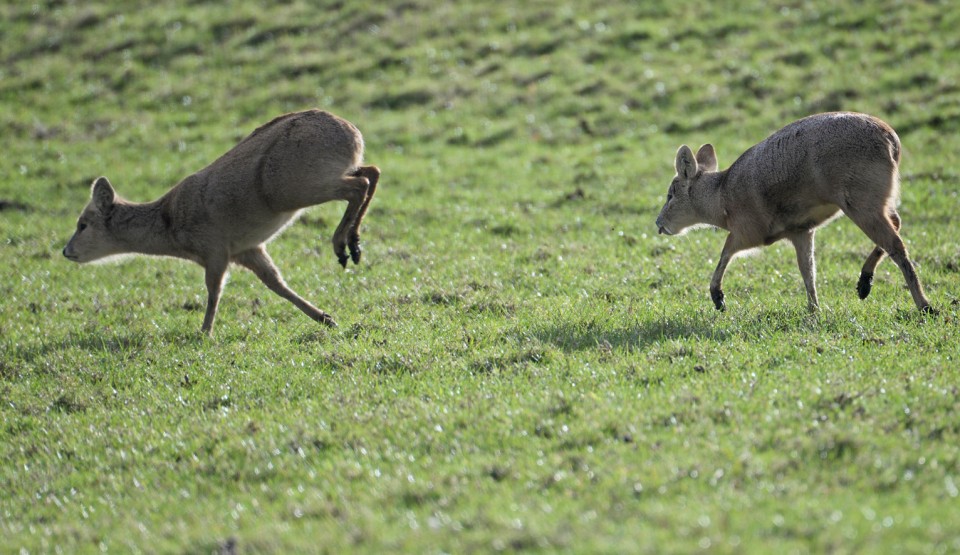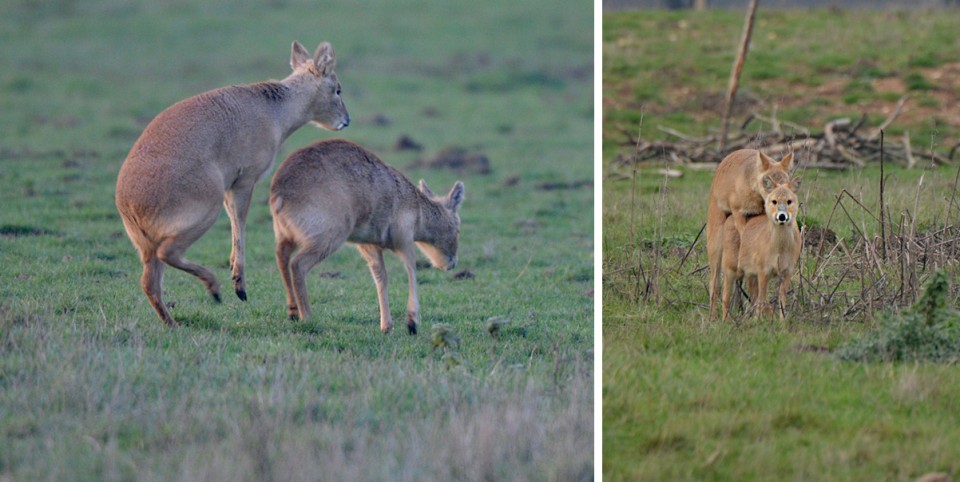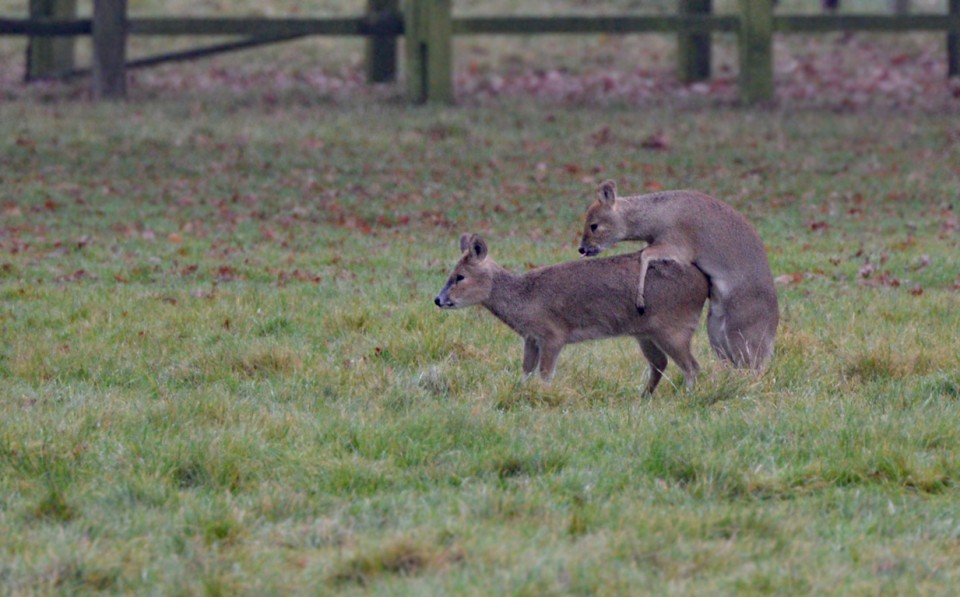Water Deer Reproduction - Mating
Observations of copulation are relatively rare for this species, perhaps because much like their general courtship behaviour, much happens at night and in cover. Nonetheless, we have a few accounts in captivity, and from the wild in China, France and Britain, including two occasions caught on Arnold Cooke's trailcams at Woodwalton. Endi Zhang, during his Ph.D. fieldwork at Whipsnade, recorded six matings over in the winter of 1993/94, while Dubost and his colleagues saw only 11 during 317 hours of observation at Branféré. I have observed mating four times in free-range captive animals, twice at Whipsnade and twice on the Woburn Abbey estate.

At Whipsnade, Stadler considered there to be seven phases to copulation, starting with the mounting pursuit, which involved the buck trotting behind female, head held lower than the shoulders, keeping pace and distance from each other. Males usually adopted a neck-stretch and headshake (i.e., ear slap) while sniffing at the female's tail/rump. This pursuit tended to last for at least a minute, and it's interesting to note that neither Stadler's account, nor my observations or any of the other descriptions I have come across of this behaviour include the tongue-flicking we see in other species, such as muntjac. It is worth noting that I have seen this same behaviour several times without a subsequent mount, so it may also be part of general courtship as well as preceding copulation. During one instance of this behaviour, which ended without mating, the female was seen to headshake while being pursued.
Michael Clark, in his 1981 book Mammal Watching, draws a parallel between the mating chase of water deer and that of rabbits and hare, writing:
"Four may run together and the does do look as if they prompt certain bucks to keep interested when pursuit flags."
Similarly, at a site in Norfolk during late December 2019, naturalist and artist Sophie Walker described on her social media channel how:
"I started filming one doe as she was walking up to a buck, who was laid up in the field licking what I presume was some rutting wounds. I could see tufts of hair coming out from his side - perhaps from a previous battle? As the doe approached the buck I caught them on camera 'checking out each other out'. She appeared to be in season, as she began to scrape the ground with her front feet and then marked the scrape with urine and she repeated this process 4 or 5 times. In between she would sniff the air, lifting her head high to see if the buck was looking! She trotted about trying to catch his attention, but this buck was just busy licking his side, he knew she was there but showed her no interest. She eventually gave up and went to lie down in the hedgerow by herself."
One wonders, perhaps, whether this was actually an immature (first winter) male, rather than a doe, although a similar behaviour was described in red deer (Cervus elaphus) by John Fletcher in his A Life for Deer, in which he noted how if a hind hasn't been mated come December, she is "rampant with overt urge to be mated and solicits the stag shamelessly". Given the short duration for which females are in oestrus, it seems logical that they may try and attract a male's attention if they get towards the end of the season unmated. It remains to be seen, however, how common female solicitation is among water deer. I have never personally observed the behaviour Sophie described, nor seen more than a single buck pursuing a doe at any given time, although I have observed what I initially took to be a doe "prancing" near a buck in Norfolk that closer inspection suggested was actually a juvenile buck. In Muntjac and Water Deer, Arnold Cooke noted:
"... females are largely unimpressed by any male until they come into oestrous - then it seems they may mate with the first one they encounter."
Interestingly, the faecal progesterone metabolites profile data collected by Robert Mauget and his colleagues at Branféré suggested that conceptions happened between 24th November and 19th December and that most females conceived at their first ovulation, but the researchers never saw any significant behaviour that reflected a change in their state of sexual receptivity. This, they suggest in a 2007 paper to Mammalian Biology, might explain why bucks constantly monitored does over several weeks before mating with them - it was never that obvious when they were in season. The profiles also indicated that silent ovulations occurred at the onset of the breeding season.

Stadler called the next part of the sequence licking tail; when a receptive doe stops, and the buck licks her perianal area. I have observed this behaviour on two occasions and have seen video footage from South Korea of a buck walking behind a female with his nose pressed into her perianal region as she held her tail horizontally out of the way (i.e., licking tail without the female having stopped). Dubost and his team noted, in their 2011 paper to paper to Acta Theriologica, that the pursuit occasionally involved the buck sniffing at a doe's genital region, but never licking it, while Francois Feer reported a buck licking the genitals of a doe on two occasions. In both cases of genital licking that I witnessed, the female moved a couple of metres away and stood to accept the buck. There was no sign of a flehmen response from the buck having completed licking as there is when sampling urine. I have also observed bucks pressing their noses into the genitals of does on a couple of occasions, without licking, resulting in flehmen.
Receptive females stop after some time of pursuit, standing firmly with legs slightly apart, and lift their tails - this copulatory stance is an invitation for the buck to mount. When confronted with this copulatory stance, Stadler found a male would always mount the female, placing his front legs around her midriff and laying his chin on her back/shoulders. He observed that mounting was not properly directed in some cases; males attempting to mount from the side, rather than from behind. I have seen males attempt to mount females who then continued walking, causing the male to assume an ungainly bipedal walk behind her for a few steps before collapsing forward.

During copulation, bucks often exhibited a treading on the spot, with both hind legs alternating, and Stadler observed this in all 18 matings. Copulation itself was short, lasting on average between three and ten seconds (in the literature the range seems to be 1-17 seconds), and was proceeded by an ejaculatory thrust in most (all successful?) cases. Stadler noted that the thrust occurred in three-quarters of the copulation events he observed, although in a couple it was difficult to discern if it had happened or not. Indeed, in the three copulations I have seen, the thrust is rather muted compared with other deer. Once the pair separate the male engages in penis licking for a few seconds before returning to some other activity, while the doe moves a few metres away and either resumes feeding or lies down. In one instance, I observed the doe defaecate before lowering her tail and lying down. There does not appear to be any genital licking/grooming by the doe.
Other observers document a similar process in terms of the courtship and mating to those recounted by Stadler, albeit in fewer discrete sections. There have also been a couple of behaviours described that Stadler did not document and do not appear to have been widely observed. During his 1982 study, for example, Francois Feer noted that water deer may be the only cervid to engage in the "Laufschlag" (mating-kick), a behaviour well known among bovids where the male tests the female's readiness to mate by gently kicking her between the rear legs with his front foot; if she remains in place, he will then mount her. This was apparently described by Peter Scherpe among his captive animals held at Berlin Zoo, and Feer observed a similar kicking motion in his buck. I have never seen a buck do this and know of no other description. Additionally, during the 2016/17 winter rut, Sharon Scott described a buck chasing a doe:
"The buck ran at the doe with his head down, ear-flapping and she ran away squeaking, closely followed by him. She turned a couple of times during the chase and they danced around each other squeaking before she allowed him to mount her."
As with the laufschlag, I know of no other description of such pre-copulatory behaviour in this species and am interested to hear from anyone with experience of either.
In his research notes, Chaplin mentioned that a buck will continue to scent mark after mating and try to lick the doe's rear, although she's usually uninterested again and he typically does not pursue her. Stadler, Dubost and Arnold Cooke, however, all describe males repeatedly courting and mating a single female. The buck sometimes breaks off this repeated courtship to evict interloping males. The doe remains within his territory resting or feeding while he's gone, and between copulations. Dubost and Stadler note that the pair will often lie together during inter-copulatory periods, and this is something I have observed at Whipsnade and Woburn, and in the wild. It's also not uncommon to see a buck and doe resting and/or grazing in close proximity during the rut, and in my experience, these typically represent a "couple". Stadler followed a pair over four consecutive hours during which six copulations were recorded, each about 40 minutes apart.
Patience is a virtue?
The importance of territory means it's typically only mature bucks that will mate, and Gérard Dubost and his colleagues found that bucks at Branféré Zoological Park didn't copulate or obtain a territory before their second winter, at around a year and a half old. Both Stefan Stadler and Endi Zhang observed much the same at Whipsnade, recording immature bucks courting females without success and, in Muntjac and Water Deer, Arnold Cooke comments that while first-winter bucks have occasionally held compartments (territories) at Woodwalton Fen, their mating success remains unknown and, overall, young bucks are unlikely to be as successful as mature males, particularly where the density is high. Similarly, Lixing Sun and Nianbua Dai noted how two first-winter males roamed around the territorial ground during their study at Poyang Lake in China, but were never observed to mate. Nonetheless, during Stadler's study, a six-month-old male fawn was observed copulating with an adult female, although it did not appear to end in successful ejaculation (i.e., no copulatory thrust or penis licking was recorded).

More recently, in January 2012, near Woburn, naturalist Stephen Plummer filmed what appeared to be a young buck mounting an older doe and, not far from Stephen's site in 2016, I photographed what I took to be a six-month-old fawn mount an older female. The following is taken from my notes of 10th December:
"... we observed a young buck (no obvious tusks protruding, but inspection of photos revealed a penis sheath) approach a doe at a trot and both animals engaged in ear-slapping (subsequent observation of the doe found her to shake her head periodically, perhaps indicating an irritation) before the buck walked around the doe and mounted her - based on the timings of the photos, the mounting lasted about 16 seconds, during most of which the male had his tongue out. Once the male had dismounted, he laid down without any penis licking (unsuccessful?) and she continued to graze. The buck would allow the doe to walk a few metres away before getting up and chasing after her, only to lie down as she continued to feed. There was some vigorous chasing when this male spotted another pair of Cwd further down the field; he gave persistent chase to remove one of the deer (a buck, presumably) from the vicinity, before running back to the doe he'd mounted earlier and lying down again."
Consequently, it may pay younger males to remain persistent late into the season, when adult bucks may be tiring, females are more dispersed, and first-winter females may be coming into oestrous or older does missed by mature bucks.